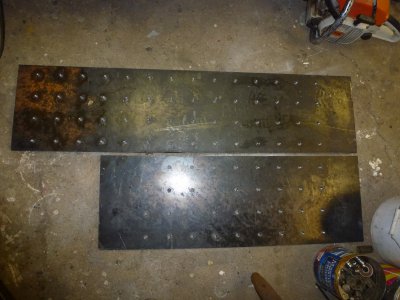- Joined
- Feb 7, 2013
- Messages
- 2,485
With the arrival of more winterlike weather, I decided it was time to make a welding table. Presently we have light
snow and 6 degrees Farenheit or about-14 Centigrade.
I picked up several pieces of 1/2 inch thick mild steel for the table top and some square tubing for the support legs and braces.
It is going to be heavy and I would like it movable so planning to use some pneumatic garden tractor front wheels on one end
and a pair of handles on the leg end so I can roll it around and out of the shop if desired. More on that part later I guess.
The steel I purchased was anything but square and was cut off with a torch so the first step was to use a carbide end mill and
mill the long sides parallel and the ends square with that. It was over a half inch from parallel so there was a lot of mill work
to do to get it reasonably straight. With that done, I got set up to mark where holes were to go and then proceed with drilling
and tapping. It looks like the tapping will have to be done in two setups on the mill to drill all the holes using my digital
readout on the mill for accurately spaced holes. I tried a number of taps and found that the three flute bottoming tap worked the
best so have been using that to do the tapping. I started the tap holes using the mill with a through tap enough to get the
verticality established and hand tapped from there.
It is a fairly big endeavor so am taking a break for a bit to post a few photos. These are the two steel plates for the table top.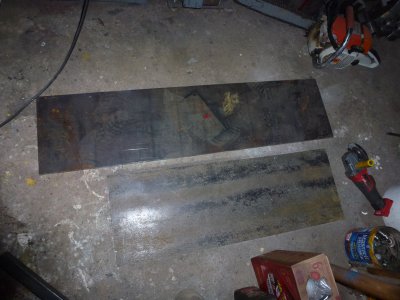
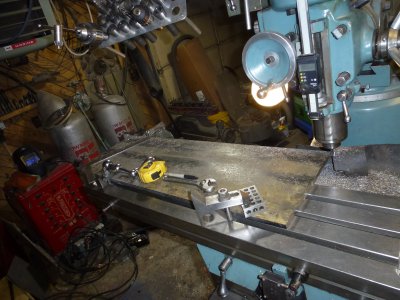 This photo is my setup for milling the table top parallel.
This photo is my setup for milling the table top parallel.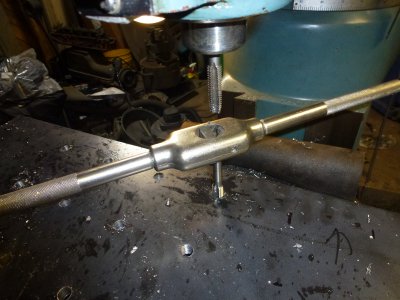
This is how I started the tap with the mill and finished up by hand tapping, worked ok but somewhat slow. The holes are straight though
and no broken taps so far...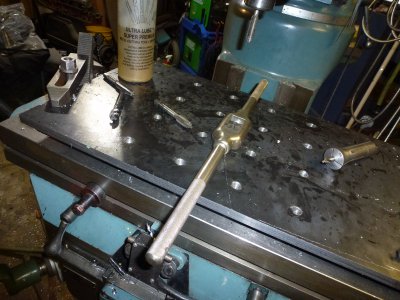
The Ultralube worked pretty well to make the tapping of the 1/2 inch holes easier. I will be able to use my milling clamps right on the
welding table if desired so that will be handy. Also, I will allow a space between the two plates for various clampage applications.
Well, that's it for the moment. I hope everyone is having a good day in HM land.
snow and 6 degrees Farenheit or about-14 Centigrade.
I picked up several pieces of 1/2 inch thick mild steel for the table top and some square tubing for the support legs and braces.
It is going to be heavy and I would like it movable so planning to use some pneumatic garden tractor front wheels on one end
and a pair of handles on the leg end so I can roll it around and out of the shop if desired. More on that part later I guess.
The steel I purchased was anything but square and was cut off with a torch so the first step was to use a carbide end mill and
mill the long sides parallel and the ends square with that. It was over a half inch from parallel so there was a lot of mill work
to do to get it reasonably straight. With that done, I got set up to mark where holes were to go and then proceed with drilling
and tapping. It looks like the tapping will have to be done in two setups on the mill to drill all the holes using my digital
readout on the mill for accurately spaced holes. I tried a number of taps and found that the three flute bottoming tap worked the
best so have been using that to do the tapping. I started the tap holes using the mill with a through tap enough to get the
verticality established and hand tapped from there.
It is a fairly big endeavor so am taking a break for a bit to post a few photos. These are the two steel plates for the table top.

 This photo is my setup for milling the table top parallel.
This photo is my setup for milling the table top parallel.
This is how I started the tap with the mill and finished up by hand tapping, worked ok but somewhat slow. The holes are straight though
and no broken taps so far...

The Ultralube worked pretty well to make the tapping of the 1/2 inch holes easier. I will be able to use my milling clamps right on the
welding table if desired so that will be handy. Also, I will allow a space between the two plates for various clampage applications.
Well, that's it for the moment. I hope everyone is having a good day in HM land.
Last edited:



